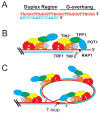Maintaining the end: roles of telomere proteins in end-protection, telomere replication and length regulation
- PMID: 21945241
- PMCID: PMC3256267
- DOI: 10.1016/j.mrfmmm.2011.08.011
Maintaining the end: roles of telomere proteins in end-protection, telomere replication and length regulation
Abstract
Chromosome end protection is essential to protect genome integrity. Telomeres, tracts of repetitive DNA sequence and associated proteins located at the chromosomal terminus, serve to safeguard the ends from degradation and unwanted double strand break repair. Due to the essential nature of telomeres in protecting the genome, a number of unique proteins have evolved to ensure that telomere length and structure are preserved. The inability to properly maintain telomeres can lead to diseases such as dyskeratosis congenita, pulmonary fibrosis and cancer. In this review, we will discuss the known functions of mammalian telomere-associated proteins, their role in telomere replication and length regulation and how these processes relate to genome instability and human disease.
Copyright © 2011 Elsevier B.V. All rights reserved.
Conflict of interest statement
Figures


References
-
- de Lange T, Lundblad V, Blackburn EH. Telomeres. Cold Spring Harbor Laboratory Press; New York: 2006.
-
- Gilson E, Geli V. How telomeres are replicated. Nat Rev Mol Cell Biol. 2007;8:825–838. - PubMed
-
- Verdun RE, Karlseder J. Replication and protection of telomeres. Nature. 2007;447:924–931. - PubMed
-
- d'Adda di Fagagna F, Reaper PM, Clay-Farrace L, Fiegler H, Carr P, Von Zglinicki T, Saretzki G, Carter NP, Jackson SP. A DNA damage checkpoint response in telomere-initiated senescence. Nature. 2003;426:194–198. - PubMed
Publication types
MeSH terms
Substances
Grants and funding
LinkOut - more resources
Full Text Sources

